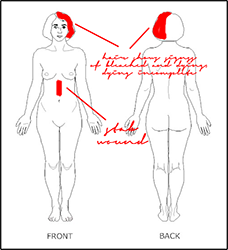We already have 5 players accepted and 2 pending CS for the RP.
Only 2 (possibly 4) slots available!
Rookery Member
- Last Seen: MIA
- Joined: 10 yrs ago
- Posts: 408 (0.11 / day)
- VMs: 0
-
Username history
- Rookery 10 yrs ago
Status
User has no status, yet
Bio
User has no bio, yet
Most Recent Posts
Characters Accepted:
BlackCat your CS needs a little more detail but the quality is already good. I'll consider it as a place-holder.
I'll write up the IC, boy, this went so fast.
- Dan Evary - Boboclown89
- Chris Richards - Liriia (comment:
 )
)
BlackCat your CS needs a little more detail but the quality is already good. I'll consider it as a place-holder.
I'll write up the IC, boy, this went so fast.
Mr Allen J said
Excellent. When can we see an IC?
5-7 Players with Characters, I'll post an IC but I'll leave it open until 9 players are participating.
Characters Accepted:
I'll just consider them as place-holders, if it's still a WIP by the time IC is up, then I'll request an edit, just to keep things neat.
It's completely up to you :)
- Shannon Jacqueline Balore - Mr Allen J
- Deborah Lillian Termellio - Mr Allen J
- Lisa Daniels - Konica
- Isaac Clayton - PureThoughts
- WIPs will be consider place-holders.
Mr Allen J said You know, one thing that irritates me to no end is when people post "WIPs" If your sheet's not finished then what's the point of posting it?
I'll just consider them as place-holders, if it's still a WIP by the time IC is up, then I'll request an edit, just to keep things neat.
Konica said How much do we know about the victim?
It's completely up to you :)
Mr Allen J said
Oh, and I'd like to know if this is a college? High school? Kindergarten?
Lols, you'll find all the information under the "Setting, Theme and Twists". To answer your question, it's set in a University.
Mr Allen J said
I'll likely make two characters and leave it at that.Don't worry, I'm very good at handling multiple characters, and like it that way so that I can write from multiple perspectives.
I'm just trying to keep things fun, clean and smooth flowing :P I get really iffy when I see clutter *laughs*
Mr Allen J said
How many characters are we allowed? Since I kinda have an idea for two, maybe three.
Ideally one character per player, but you're free to create up to three (3) characters.
EDIT: Keep in mind, you must keep track of all of them. If you decide to drop one character, please inform me here in the OOC, so I can write up an event that makes him/her irrelevant In-Character. I believe I should give a plot penalty if that happens.
The OOC is up and running! I hope to see you guys there :D

Shoot Your Gun by 22-20s
Liar, Liar is a Murder/Mystery themed RP. There is no predefined setting asides that it’s taking place within a University. The players have creative freedom, they are free to define their surroundings.
Unlike other RPs, this one has a few twist on how things will play out:
- The murderer is one of the players but none of them nor the GM will chose or be chosen for the role. The murderer will be chosen In-Character. For the sake of fair play, a player should treat their character(s) as innocent and suspect others, until otherwise specified by the GM, who will provide unbiased judgment regarding scenarios questioning a characters guilt.
- Each character is an unreliable narrator. The credibility of an unreliable narrator is in question hence one should always assume they’re not being completely honest. For the sake of consistency, a players should treat their character(s) as truthful (reliable) narrator and the others not, until otherwise specified by the GM, who will provide unbiased judgment regarding scenarios questioning a characters reliability.
- Characters won’t have backgrounds. Instead they’ll have statements pertaining to their relationship with the victim, their alibi and motive. For example: 1) I’m the best friend, 2) I was asleep, and 3) She was always nice to me. Two out of the three statements are lies. The players nor the GM know which statements are lies and like the identity of the murderer, it will be decided In-Character.Relationship Statements are limited to members of the school (classmate, teacher, headmaster, etc.), family (mother, father, sister, brother, cousin, etc.), and friends/enemy (best friend, friend, worst enemy, enemy, rival, acquaintance, stranger (I don’t know her statements), etc.). Overlapping relationships are allowed (i.e. teacher and father) but will only be considered as one statement.
- The detective(s) role is reserved by the GM. The detective(s) are Non-Playable Character(s) (NPC). They can be referred and characterized by other players but they’re not allowed to partake in scenarios.
- A player is allowed to create up to three characters. Ideally, a player should only have one character. If a player decided to drop one or more of their characters, they’re required to inform the other players and the GM in the OOC. The GM will then deem these characters are irrelevant to the plot. The remaining character(s) of the player will incur plot penalties.
The initial IC post will establish the setting. This is done by the GM. The RP is then divided into phases. Phase 1 is where the players introduce their characters, no turn order, one post per player until every player has introduce their character(s).
The following phases begins with a scenario created by a player. A scenario can range from re-enforcing their character’s innocence, question another character’s credibility, developing the plot, etc. Other players will then conform or oppose the scenario. A scenario will continue until it has matured (base on the judgment of the GM) and/or concluded (base on the activity of the players).
Scenarios should be considered non-canon until otherwise specified by the GM, who will provide unbiased judgment regarding the plausibility of the scenario. If deemed plausible, the scenario is canonized. Scenarios are judge by three criteria: Plot Development (Does the scenario progress the storyline?), Plausibility (Does the scenario make sense?), and Interconnections (Does the scenario conform to canon?).
The players take turns in creating a scenario, one scenario per phase, turn order is determined by the GM. Phases continue until the murderer is caught.
To determining the identity of the murderer, a character must have amass enough suspicion with corresponding evidences. Suspicion is generated by scenarios questioning a characters credibility and were deemed canon. Determining a lie/liar requires far less. Scenarios that conflicts with a characters statement and/or their previous scenarios which were deemed canon are enough and will generates suspicion.
Hint: If you’ve notice, it’s easier to create scenarios during the early stages of the RP but as it goes on, it’s harder to create new storylines. If your character is considered the prime suspect, it’ll be harder for you to shift the suspicion on someone else.
Game Flow Aids:
Mysteries - Mysteries are important plot points that require answers else a plot loophole occurs. They may be answered by the players. The GM will naturally fill in plot loopholes.
Suspicion and Plot Penalties – Suspicion is an abstract concept within the RPverse hence it can’t be track. If character generates suspicion they incur a plot penalty. Plot Penalties shouldn’t be considered as suspicion points since one can incur them multiple ways (conflicting scenarios). They function more like credibility trackers. If a character incurs more and more plot penalties, the least credible they become.
Plot Penalties will never prevent a player from posting. They can however force truths, change or add statements, provide character traits (such as boy/girlfriend of the victim, having an affair with the victim’s boy/girlfriend, hospitalized, etc.). Plot Penalties highly depend on the scenario from which it was generated/incur.
Suspicion and Plot Penalties – Suspicion is an abstract concept within the RPverse hence it can’t be track. If character generates suspicion they incur a plot penalty. Plot Penalties shouldn’t be considered as suspicion points since one can incur them multiple ways (conflicting scenarios). They function more like credibility trackers. If a character incurs more and more plot penalties, the least credible they become.
Plot Penalties will never prevent a player from posting. They can however force truths, change or add statements, provide character traits (such as boy/girlfriend of the victim, having an affair with the victim’s boy/girlfriend, hospitalized, etc.). Plot Penalties highly depend on the scenario from which it was generated/incur.
1. Fundamental Rules of the Guild will be observed and enforced.
2. Posting Standard: Casual – Proper grammar and structure is observe. Please keep your minimum post length between 1-2 paragraphs. More is encourage.
3. Content Standard: High Casual – For the RP to progress one or more must be present in a players post, characterization, plot-pushers, and/or plot-points. Idle conversation/interaction is discourage but won’t be moderated strictly (that’s for Advance RPs).
4. Fair Play and Observe Standards: No godmodding, no speedposting, avoid literally flaws such as Mary Sue/Gary Stu, incomplete characters a.k.a. “Dumb Jane/Joe”, Omnipotence, Meta-Gaming and the like. It’s unpleasant for other players and unbearable for most.

Stefan0620 has given me his blessing. I'll be GMing this RP.
OOC will be up by tomorrow.
Asides from writing up an interesting background, I'm also writing up guidelines regarding mech designs. Hopefully, these guidelines would agree with everybody :)
OOC will be up by tomorrow.
Silverwind Blade said
Hello, I am also interested in this, depending on how it develops in terms of depth of plot and how constrained by realism it is. By which I mean, if we have to account for every system of every part of our mecha having a real explanation in terms of what it's made from, powered by, what it shoots, etc. then I wouldn't be interested. However, if there's a consistent tech-base and tech-level for everything that doesn't make the setting look like a 'mech-blender', then I'm definitely interested. And if the background is good too.
Asides from writing up an interesting background, I'm also writing up guidelines regarding mech designs. Hopefully, these guidelines would agree with everybody :)
© 2007-2024




